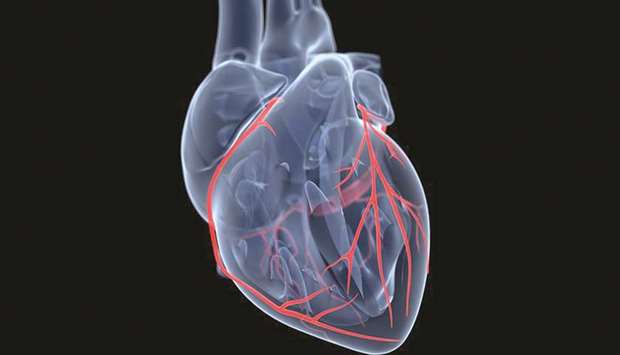
By Cardiologist Prof Dr Raveendran
Heart is the most hard-working muscular organ in the entire human body which pumps blood throughout the body, providing oxygen and nutrients to each and every body part and removing carbon dioxide and waste products out of the body tissues. Even though the heart contains blood within its chambers the heart muscle cannot take oxygen and nutrients from it, it has to be supplied through separate blood vessels which originate from the root of the aorta, known as coronary arteries. Atherosclerotic Coronary artery disease is the most common cause of cardiovascular morbidity and mortality.
What is Atherosclerosis?
Atherosclerosis is a disease in which plaque builds up inside your arteries. Arteries are blood vessels that carry oxygen-rich blood to your heart and other parts of your body. Plaque is made up of fat, cholesterol, calcium, and other substances found in the blood. Over time, plaque grows in size and hardens to cause narrowing of your arteries. This limits the flow of oxygen-rich blood to your organs. Atherosclerosis can lead to serious problems, including heart attack, stroke, or even death.
What is Coronary Artery Disease?
Coronary Artery Disease (CAD) is the most common type of heart disease. Coronary artery disease happens when atherosclerosis affects the coronaries. As the plaque grows in size, blood flow through these arteries is decreased. As a result the heart muscle can’t get enough blood or oxygen for its proper functioning. This can lead to short lived chest pain (angina) or a heart attack. Heart attacks happen when a blood clot forms over an atherosclerotic plaque producing total obstruction to blood flow, causing permanent damage to heart muscle.
When heart attack involves large area of heart muscle it can cause reduced pumping function of the heart. This condition is called heart failure. Heart attack can also cause abnormalities of heart rhythm, either with or without heart failure, which can be fatal.
Can atherosclerosis affect other organs?
Yes. It can affect arteries supplying blood to the brain, kidney legs and other organs.
Ischemic stroke: Ischemic stroke is the most common type. It is caused by atherosclerosis affecting blood vessels to the brain.
Peripheral Arterial Disease: Peripheral arterial disease is most commonly due to atherosclerosis affecting arteries to the legs. It can result in calf pain while walking, and in severe cases, can cause gangrene requiring amputation of the limb.
What are the symptoms of Coronary Artery Disease?
Asymptomatic phase: When the plaque is small and causes less than 50% narrowing of luminal diameter, the person will not experience any symptom whatsoever.
Angina: This is felt as heaviness or constriction in the middle of chest as if from beneath the breast bone, usually brought on by physical or emotional stress, lasting for 3-5 minutes. It is usually relieved by rest, or sublingual or buccal use of nitroglycerine. A sharp well localised pain or pain lasting for only a few seconds is not considered angina. The presence of angina indicates that there is 50% or more diameter narrowing of one or more coronary arteries.
Heart attack (Myocardial Infarction): When somebody develops typical pain as described above lasting for more than 15 minutes, it is likely that they have heart attack. Commonly the pain may radiate to shoulders, arms, sides of neck, lower jaw, upper abdomen or to the back. It may be associated with profuse sweating, shortness of breath, giddiness or vomiting.
Cardiac arrest: In a significant number of people the first symptom of heart attack is sudden collapse and falling unconscious with no pulse and absent or gasping respiration. The person dies unless somebody delivers effective Cardiopulmonary resuscitation within 3-5 minutes.
Heart failure: When a significant area of heart muscle is dead or dysfunctional due to lack of adequate blood supply, the pumping function of the heart is reduced and it results in swelling of legs, fatigue and shortness of breath.
How big is the problem?
Cardiovascular disease, which includes heart attack and stroke, is the number one cause death all over the world: over 17 million deaths annually, representing 31% of all global deaths. One third of all people developing Myocardial infarction (heart attack) die before reaching hospital, most of them within the first hour. There is an alarming increase in developing countries especially India, the Middle East, North Africa and South East Asian countries. It is caused by rapid urbanisation and modernisation and significant changes to diet and lifestyle. Age at presentation appears to be significantly younger in these regions compared to global averages. Increased rates of all major risk factors including diabetes, hypertension, hyperlipidemia, smoking, obesity, and sedentary lifestyle have been noted.
Who is at the risk of Coronary Heart Disease?
Certain genetic traits, health conditions, or habits may raise your risk for CAD. The more risk factors you have, the more likely you are to develop the disease.
The risk factors are mainly divided into two:
* Non-modifiable, which we cannot do anything about
* Modifiable, which we can control
Non-modifiable risk factors:
Age: In men, the risk for coronary artery disease increases by age 45yrs. Women are at risk beyond age 55yrs.
Sex: Men are more at risk compared to women. Beyond age 55yrs the risk equalises.
Race: Some racial groups are having more risk. This is true for American blacks.
Heredity: If your 1st degree male relative had heart attack at age <55yrs, or 1st degree female relative had heart attack at age <65yrs, you are at risk because of heredity or genetic predisposition. If your 1st degree relative has heart attack beyond this age, you are not considered at risk because of heredity. If you have a strong family history of premature coronary artery disease, don’t get disheartened, you can reduce your risk by controlling other modifiable risk factors.
Modifiable risk factors:
Smoking:
Smokers have more than twice the risk of having coronary artery disease than non-smokers. Cigarette smoke contains around 4000 chemicals out of which at least 200 are directly harmful to human body. Smoking can increase heart rate, blood pressure and LDL cholesterol. It can also cause direct injury to arterial wall causing narrowing of arteries and also atherosclerosis.
The recommendation regarding smoking is:
* Smokers should quit smoking
* Those who don’t smoke should never start smoking
* If anyone in your family or friends’ circle smoke, motivate them to quit
* The benefits of smoking cessation start appearing within 24 hours of quitting. By 1-2 years the risk decreases by 50%, and by 5-10 years the risk reaches the level of a never-smoker.
High Blood Pressure (Hypertension):
The prevalence of high blood pressure is 25-30% in adults in most of the societies. This means one in every 3-4 person is having hypertension, making it the most common risk factor for atherosclerosis. Persons with hypertension are having twice the risk of having heart attack compared to persons with normal blood pressure.
Hypertension can be controlled with diet control, exercise and if necessary with drugs in addition. Once you are started on medications for hypertension you should not stop it without consulting your doctor even if your blood pressure is well controlled.
Diabetes:
At any given cholesterol level, diabetic persons have a 2 or 3 times higher risk of heart attack or stroke
A diabetic is more likely to die of a heart attack than a non-diabetic.
80% Diabetics die from heart disease.
Risk of sudden death from a heart attack for a diabetic is the same as that of someone who has already had a heart attack. All adults should have their blood sugar checked regularly, as there are no early symptoms of diabetes.
Normal blood sugar:
Fasting < 100mg%; post meals <140%, HbA1C <5.7%
If high:
* Modify your lifestyle – Diet, Weight control, Exercise
* Medication if blood sugar not at target
* Adhere to the prescribed medication without fail, to decrease chances of getting heart disease
* Do not stop your medicines without consulting your doctor, even if the blood sugar becomes normal
Abnormal levels of blood cholesterol (Dyslipidemia):
Your body needs cholesterol. It circulates in the blood and serves several vital functions in the body. Too much cholesterol can deposit in the arteries in the form of plaque and block them. It may not produces any symptoms till heart attack. There are two sources of cholesterol in the body: Food & made in your body itself. The important food sources are meat, poultry and full-fat dairy products.
LDL cholesterol is known as bad cholesterol. It has a tendency to increase risk of heart attack. HDL cholesterol is known as the good cholesterol because HDL it helps remove some of the bad cholesterol out of arteries, carrying it back to the liver for metabolism.
The dietary fat can be grouped into different types depending on the molecular composition. Coconut oil, palm oil, ghee etc. contains saturated fat which increase cholesterol and are better avoided or restricted. Olive oil, groundnut oil, canola oil, mustard oil etc. contain monounsaturated fat (MUFA), and sunflower oil, soybean oil etc. contain Poly-unsaturated fats (PUFA). Both mono- and polyunsaturated fats are heart healthy. Dairy products, partially hydrogenated vegetable oils and the like contain trans-fats which are unhealthy and promote atherosclerosis.
The dietary recommendation regarding fat intake is:
* 20 to 35 % calories only from fat
* <10% calories from saturated fat
* Replace solid fat with oils when possible
* Limit intake of trans fat and cholesterol
* The cholesterol targets for treatment:
* Total cholesterol < 200mg/dl
LDL Cholesterol
* Low risk <160
* Intermediate risk <130
* High risk/diabetes <100
* Prior CAD <70
* HDL Cholesterol >40 for men >50 for women
Triglycerides <150
Obesity:
The obese have 2 to 6 times the risk of developing heart disease. Obesity is measured by different indices like body mass index (BMI), waist circumference and waist/hip ratio.
Normal BMI: 20-25
Normal waist circumference:
* <35 inch for women
* <40 inch for men
* Normal Waist-Hip Ratio
* < 0.85 for women;
* < 0.95 for men
Pear-shaped paunch store fat on the hips and thighs, just below the surface of the skin.
Apple-shaped paunch store body fat around the abdomen and chest, surrounding internal organs
People with apple-shaped obesity are more vulnerable to heart attack
Physical inactivity:
Many of us lead sedentary life, exercising infrequently or not at all. People who don’t exercise have higher rates of death and heart disease compared to people who perform even mild to moderate amounts of physical activity.
The recommendation for exercise:
* A minimum of 30 minutes of physical activity, on most of the days, to the level of 50 to 75% of maximum exercise capacity
* Exercise should be aerobic, involving large muscle groups
* Aerobic activity includes brisk walking, cycling, swimming, jumping rope and jogging
* Even leisure time activities like gardening and walking can reduce your risk of heart disease
* If walking is your exercise of choice, use the pedometer goal of 10,000 steps a day
* Anything that makes your heart beat a bit faster is good enough
* Think about what you need and consider what is convenient for you
* Every exercise session should include a warm-up, a conditioning phase and a cool-down phase
* During cardio exercise it is considered moderate if you can talk, but not sing.
* You are exercising vigorously if you cannot say more than a few words without taking a breath in between.
Exercise helps modify other risk factors:
* Reduces incidence of obesity
* Increases HDL
* Lowers LDL and total cholesterol
* Significantly reduces the chances of diabetes and stroke
* With regular exercise, blood pressure in those with hypertension is reduced by as much as 20mm Hg
* Mortality is halved in retired men who walk more than two miles every day
* Regular exercise can halve the risk of heart disease, particularly in men who walk briskly
* Someone who is inactive has as great a risk of having heart disease as someone who smokes, has high blood pressure or has high cholesterol
* Ask your doctor if you should limit the intensity of your workouts.
Alcohol consumption:
In large amounts it adds calories, raises blood pressure, raises cholesterol, depresses heart muscle strength and can produce cardiac arrhythmias.
Diet:
Eat a variety of fruits and vegetables every day (5 servings). They are naturally low in fat and high in vitamins and minerals and anti oxidants.
* Eat a variety of grain products
* Use less fat meats: chicken, fish and lean cuts
* Switch to low-fat/fat-free dairy products
* Limit your intake of foods high in calories and low in nutrition, including foods like soft drinks, candy, junk food
* Limit foods high in saturated fat, trans- fat and cholesterol
* Eat less than 6gms of salt a day
Stress:
Stress can lead to high blood pressure, high cholesterol, smoking, physical inactivity and over eating. Reduce stress by:
* Exercise
* Maintaining positive attitude
* Healthy diet
* Relaxation techniques
Interaction of risk factors:
* Risk factors often cluster together
* Risk operates across a continuum, no clear-cut line
* The risk is multiplicative when many risk factors co-exist
* Majority of events arise in individuals with modest elevations of many risk factors than from marked elevation of a single risk factor
If you or someone in your family has already diagnosed with heart disease, don’t get disheartened. Just monitor risk factors and control much more aggressively:
* Eat healthy
* Walk regularly
* Quit smoking immediately
* Keep your weight under control
* In addition to improving your heart-health, these measures are sure to enhance your appearance!
* Adhere to your medicines & listen to your doctor
What are the treatment options for Coronary Artery Diseases?
Treatment for coronary artery disease usually involves lifestyle changes, drugs and, if necessary angioplasty or surgery
Drugs:
Various drugs can be used to treat coronary artery disease, including:
Cholesterol-modifying medications: The most important agents in this group are Statins. By decreasing the amount of cholesterol in the blood, especially LDL cholesterol, these drugs decrease the cholesterol content in the atherosclerotic plaque in the arteries thereby making the plaque less vulnerable to rupture, reducing the incidence of coronary thrombosis and acute heart attack. Statins are useful for both primary and secondary prevention of heart attack.
Aspirin: Low dose aspirin, 75-100mg daily, is given to all patients who experienced a heart attack, stroke or TIA for secondary prevention. In persons who were detected to have evidence of atherosclerosis by invasive or non-invasive evaluation, aspirin is given for primary prevention of cardiovascular disease.
Beta-blockers: These drugs slow your heart rate and decrease your blood pressure, which decreases your heart’s demand for oxygen. If you’ve had a heart attack, beta-blockers reduce the risk of future attacks. Beta-blockers are also used to control angina
Nitroglycerin: Nitroglycerin tablets, sprays and patches can control chest pain by temporarily dilating your coronary arteries and reducing your heart’s demand for oxygen.
Angiotensin-converting enzyme (ACE) inhibitors and angiotensin II receptor blockers (ARBs). These similar drugs decrease blood pressure and may help prevent progression of coronary artery disease.
What are the procedures to restore and improve blood flow?
Percutaneous Trans-luminal Coronary Angioplasty (PTCA): Angioplasty opens blocked arteries and restores normal blood flow to your heart muscle. It does not involve any major surgical procedure. It is done by threading a catheter (thin tube) through a small puncture in a leg or arm artery to the heart. The blocked artery is opened by inflating a tiny balloon and kept patent by a metal scaffold called Stents. Following angioplasty the person has to take regular medicines as prescribed with aim to prevent stent thrombosis as well as to prevent further atherosclerotic lesions.
Coronary Artery Bypass Graft Surgery (CABG):
A person whose coronary artery disease cannot be effectively managed by drugs or angioplasty can be treated by CABG, which involves creating new bypass channels between major arteries and the normal segment beyond the blocked coronary artery.
Key points for prevention:
* Control your blood pressure.
* Control your cholesterol and diabetes.
* Don’t smoke.
* Exercise regularly.
* Maintain a healthy weight.
* Eat a heart-healthy diet.
* Manage stress.
* Get regular medical checkups.
* Heart disease is often avoidable.
Following a heart-healthy lifestyle doesn’t have to be complicated, and it doesn’t mean you need to live a life of self-deprivation. Instead, find ways to incorporate heart-healthy habits into your lifestyle and you may well enjoy a healthier life for years to come.



